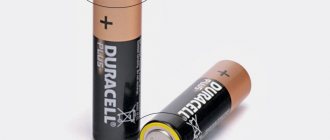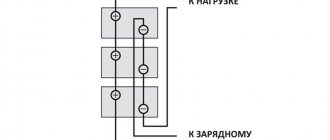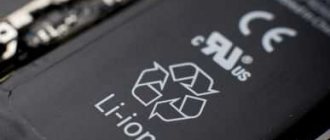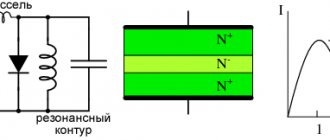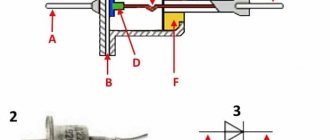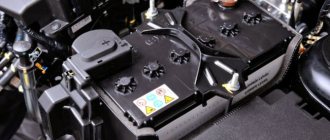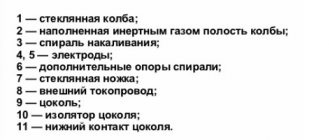A little about lithium-ion batteries
Lithium-ion batteries are one of the longest-lasting energy sources for the mobile devices and electrical appliances we use.
The main advantages of lithium-ion technology:
- high energy intensity;
- charge and discharge speed;
- small amount of self-discharge;
- small sizes.
The principle of operation of lithium-ion batteries is that energy is accumulated when lithium ions pass from the anode to the cathode through the electrolyte; during discharge, chemical energy is converted into electrical energy, which powers various devices.
In lithium-ion batteries, the cathode is made of lithium salts, the anode is made of graphite, and the separator is impregnated with an electrolyte in the form of an organic solution of lithium salts.
Such batteries are manufactured in two modifications with strict adherence to tightness:
- In the prismatic design, the electrodes and the separator, made of rectangular plates, are alternately stacked on top of each other or twisted into a spiral during roll assembly and placed in a housing with a cathode connected to it.
- In the cylindrical design, electrodes made of foil, separated by separator materials, are placed in a metal case, onto which the negative electrode is connected.
Help: Failure to seal the housing leads to battery failure.
How to replace a rechargeable 18650 battery
Another 18650 battery option.
Instead of one lithium battery, you can use 3 AA batteries. True, the quality of food will suffer somewhat, because... the voltage will not be maintained exactly. The voltage of disposable AA batteries is 1.5 V, while for rechargeable batteries it is 3.2-3.6 V.
18650 battery specifications
One of the most common types of batteries used in everyday life to power laptops, power tools, and LED lights is the 18650 battery:
- the first two digits (18 mm) – diameter;
- the second (65 mm) – length;
- third digit (0) – cylinder.
In appearance, the 18650 lithium-ion battery resembles the familiar “finger-type” battery, slightly exceeding it in size.
The technical characteristics of the battery depend on the type of electrolyte, cathode material and are within the following values:
- voltage – nominal 3.6-3.7 V, possible range from 2.5 V to 4.2 V;
- maximum discharge current – 10-35 A;
- capacity – 1100-3600 mAh.
Help: The exact parameters are indicated by the manufacturer on the product packaging.
Charging Features
Many buyers are interested in how to charge a 18650 Li-Ion battery (3.7V). You need to familiarize yourself with the features of such a process. It's quite simple. Modern manufacturers make special devices that control battery charging.
Lithium-ion batteries have virtually no memory effect. This provides a set of rules when charging and operating batteries. The memory effect is a gradual decrease in battery capacity when it is not fully discharged. This property was typical for nickel-cadmium batteries. They had to be completely discharged.
General charging requirements for 18650 batteries
How to charge the battery using the CC/CV method - constant current/constant voltage:
- CC - at the first stage, by applying a charging voltage of 0.05 V and gradually increasing it, we provide a constant charging current - the current value is 20-50% of the battery capacity (charging works as a current stabilizer);
- after reaching 4.2 V, the battery reaches about 80% capacity, which signals the end of the first stage;
- CV - in the second stage, charging occurs at a constant voltage of 4.2 V with a gradually decreasing current.
Attention! Polarity must be strictly observed, otherwise the lithium cell will fail when charging: the “minus” of the battery is flat, the “plus” has several holes and protrudes slightly.
What current to charge a li-ion battery 18650
There is a procedure for restoring the functionality of a 18650 lithium battery after the voltage drops to working voltage. We restore capacity measured in amp hours. Therefore, first we connect the Li-ion battery form factor 18650 to the charger, then we set the charging current with our own hands. The voltage changes over time, the initial value is 0.5 V. As a stabilizer, the charger is designed for 5 V. To maintain performance, parameters of 40-80% of the capacity are considered favorable.
The charging scheme for a li-ion 18650 battery involves 2 stages. First, you need to raise the voltage at the poles to 4.2 V, then stabilize the capacitance by gradually reducing the current. The charge is considered complete if the current drops to 5-7 mA when the power is turned off. The entire charging cycle should not exceed 3 hours.
The simplest single-slot Chinese charger for li-ion 18650 batteries is designed for a charging current of 1 A. But you will have to monitor the process yourself, switch it yourself. Universal chargers are expensive, but they have a display and carry out the process independently.
How to properly charge a Li-ion 18650 battery in a laptop? Connecting a set of energy sources in the gadget via Pover Bank. The battery can be charged from the mains, but it is important to turn off the power as soon as the unit has reached capacity.
How to charge a 18650 battery without a charger at home
Sometimes the question arises - how to charge a 18650 lithium-ion battery using improvised means when the factory charger is not at hand.
How to charge a 18650 battery using a phone charger
We use the power supply from a push-button telephone:
- cut off the plug connecting to the phone;
- remove the wire sheath;
- disconnect and strip one or two centimeters of wires - black “minus”, red “plus”;
- Observing the polarity correctly, tightly attach the bare wires to the terminals using tape or plasticine;
- turn on the charger;
- After an hour of charging, the battery can be used again as a power source.
How to charge a 18650 battery
The simplest charger for a 18650 battery can be made independently based on the TR 4056 - a charge module with linear current and voltage charging.
How to test a 18650 lithium battery
If, when buying an expensive device, you doubt the veracity of the information on the case, there are ways to check. In addition to special meters, you can use improvised means.
- You have a charger, you can time the time of full charging with a certain current strength. The product of time and current will reveal the approximate capacity of the li-ion battery.
- A smart charger will help you. It will show both voltage and capacity, but the device is expensive.
- Connect the flashlight, measure the current, and wait for the light to go out. The product of time and current gives the current capacity in A/h.
You can determine the power of a battery by weight: a 18650 lithium battery with a capacity of 2000 mAh should weigh 40 g. The higher the capacity, the greater the weight. But the defectors have learned to add sand to the body to make it heavier.
What to do if 18650 does not charge
A situation where the battery does not charge occurs after lithium-ion cells have been stored for a long time or have been overcooled.
Most 18650 cells are equipped with a controller that protects the battery from overcharging and prevents overheating and explosive destruction during operation.
The power controller disconnects the battery banks from the terminals when the voltage drops below the permissible level of 2.4 V - the measured voltage at the terminals of a non-working battery is 0 V.
You can increase the voltage on the battery and limit the maximum current by connecting a resistor to the circuit by assembling a circuit from a telephone power supply with a current above 0.1 A, a 300-1000 Ohm resistor with a power of 0.5-1 W and a voltmeter. We plug the charger into the network for one or two minutes - we control the voltage, after it reaches 3 V, we turn off the circuit and put the battery on charge.
Attention! We check the 18650 during the entire charging process; when it gets hot, we immediately turn off the charging - an element that gets very hot during charging cannot be restored.
Charge controller for li-ion battery 18650
Major manufacturers produce standard 18650 lithium batteries without a protective board. This controller, made in the form of an electronic circuit, is installed on top of the case, lengthening it somewhat. The board is located in front of the negative terminal and protects the battery from short circuits, overcharging, and overdischarging. Defense is being assembled in China. There are devices of good quality, but there are outright scams - unreliable information, capacity 9,000A/h. After installing the protection, the case is placed in shrink film with inscriptions. Due to the additional design, the case becomes longer and thicker, and may not fit into the intended slot. Its standard size can be 18700, and can be increased due to additional actions. If the 18650 battery is used to create a 12V battery that has a common charge controller, breakers on the individual Li-ion cells are not needed.
The purpose of protection is to ensure the operation of the energy source within the specified parameters. When charging with a simple charger, the protection will not allow overcharging and will turn off the power in time if the 18650 lithium battery runs down to a voltage of 2.7 V.
How to test a 18650 battery for functionality
We measure the voltage with a multimeter - the 18650 element is operational when the voltage at the terminals is from 2.4 V to 4.1 V; when the voltage drops below 2.9 V, the battery needs to be charged.
You can determine the capacity of 18650 by measuring the time of a fully charged tool, for example, a screwdriver. If the actual time measurement is less than that indicated on the case, the cells need charging.
Restoring li-ion battery 18650
If the battery refuses to work, it may manifest itself as follows:
- The energy source is quickly discharged.
- The battery is dead and won't charge at all.
Any source can quickly discharge if the capacity is lost. This is precisely why overcharge and deep discharge are dangerous, from which protection is provided. But there is no escape from natural aging, when storage in a warehouse annually reduces the capacity of the cans. There are no methods of regeneration, only replacement.
What to do if the battery does not charge after a deep discharge? How to restore li-ion 18650? After the controller disconnects the battery, it still has a reserve of energy capable of delivering 2.8-2.4 V voltage at the poles. But the charger does not recognize a charge up to 3.0V; anything lower is zero. Is it possible to wake up the battery and start the chemical reaction again? What needs to be done to increase the charge of li-ion 18650 to 3.1 -3.3V? You need to use a way to “push” the battery, give it the necessary charge.
Without going into calculations, use the proposed circuit, mounting it with a 62 Ohm resistor (0.5 W). A 5V power supply is used here.
If the resistor heats up, the lithium battery is zero, which means there is a short circuit or the protection module is faulty.
How to restore a 18650 lithium battery using a universal charger? Set the charge current to 10 mA, and perform precharging as written in the instructions for the device. After raising the voltage to 3.1 V, charge in 2 stages according to the SONY scheme.
18650 battery repair
There are two effective methods for restoring the functionality of elements:
- If you have a controller board, try to start the faulty battery from a working one using a parallel connection with it - use the negative “flat” contact to place both batteries on a metal surface, short-circuit the positive ones with a screwdriver.
- Remove the protection board from the battery case - if the cause was a malfunction of the controller circuit, the battery will work.
Important! Restoring the 18650 using the parallel charge and discharge method is dangerous due to the high explosiveness of hydrogen and lithium.
Which 18650 battery is better and how to choose it
When you need to choose a lithium battery, it is better to use brands from generally recognized manufacturers, such as Samsung or Panasonic. If you have a tester, you can check the capacity stated in the technical specifications. It must be remembered that these batteries, although they have many advantages, are sensitive to excess charge or discharge. Therefore, it is better to use a protected battery. But you need to make sure that it will fit into the battery slot and that the technology used does not have built-in protection.
How to make a battery from 18650 batteries
To do this, connect the poles of the batteries. With the series connection method, each positive pole is connected to a negative one. In a parallel connection, it’s the other way around—the plus is connected to the minus.
Both methods are used depending on the goals and objectives pursued when creating the battery. In the first case, the connection is used when it is necessary for the entire assembly to be turned on at the right moment. In the second case, you can turn on the required number of batteries when required.
Application of 18650 batteries
18650 batteries are a common power source because they have many advantages over other power devices. They are used where it is necessary to maintain a charge for a long time at a small size. These are flashlights, players, laptops, electric scooters and other household appliances.
Battery braid
The battery housing is braided. This is shrink film. After using for a long time, chips, cracks, roughness appear on it and it becomes unusable. You can replace the braid yourself by purchasing special heat shrink. You must first carefully remove the battery from the old coating, insert it into a new film and seal it using a hairdryer or any other heat source.
How much do batteries cost?
High-quality batteries are not cheap, but this is exactly the case when it is better not to save. The cost of these devices will be recouped through repeated use.
The difference between 18650 and AA batteries
The main factors are capacity and reusability. The minimum voltage of 18650 batteries is 2 times that of AA batteries. Therefore, in the case of replacing 18650 AA batteries, you should calculate the resulting total value of this parameter and compare it with that indicated in the technical characteristics of the battery. After this, evaluate the possibility of exceeding or decreasing the voltage of the device in which batteries are used, paying attention to the permissible deviation values.
What does protected battery mean?
This means protection against too high a charge and, as a result, overheating or overdischarge, which leads to the unusability of the device. The presence of protection is indicated in the description of the device and using the corresponding inscription on the case. However, protected batteries are 2-3 mm longer, which should be taken into account when choosing.
18650 specifications table
The parameters of some types of batteries are shown in the table below.
| Voltage, V | Maximum permissible current, A | Capacity, mAh | Availability of protection |
| 3,6 | 18 | 1 300 | +/- |
| 3,6 | 20 | 3 200 | +/- |
| 3,6-3,7 | 20-25 | 3 400 | +/- |
| 3,6-3,7 | 20-30 | 3 600 | +/- |
